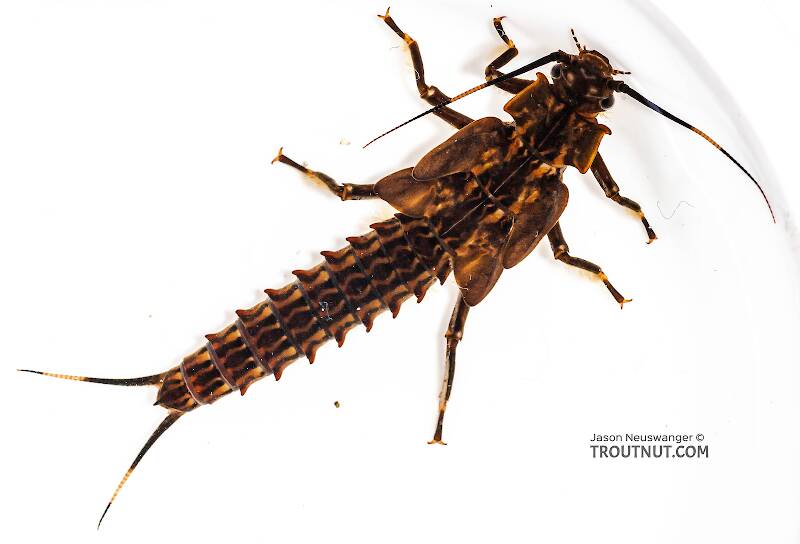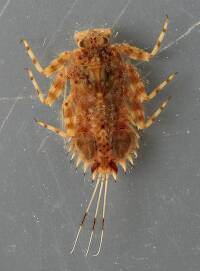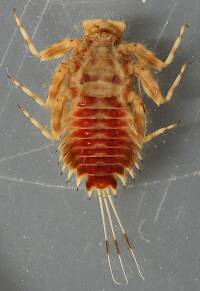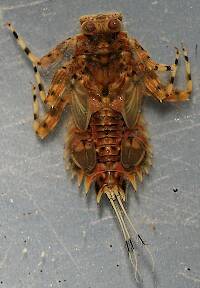
Salmonflies
Pteronarcys californica
The giant Salmonflies of the Western mountains are legendary for their proclivity to elicit consistent dry-fly action and ferocious strikes.
Featured on the forum

It's only barely visible in one of my pictures, but I confirmed under the microscope that this one has a prosternal horn and the antennae are mid-way between the eyes and front of the head capsule.
I'm calling this one Pycnopsyche, but it's a bit perplexing. It seems to key definitively to at least Couplet 8 of the Key to Genera of Limnephilidae Larvae. That narrows it down to three genera, and the case seems wrong for the other two. The case looks right for Pycnopsyche, and it fits one of the key characteristics: "Abdominal sternum II without chloride epithelium and abdominal segment IX with only single seta on each side of dorsal sclerite." However, the characteristic "metanotal sa1 sclerites not fused, although often contiguous" does not seem to fit well. Those sclerites sure look fused to me, although I can make out a thin groove in the touching halves in the anterior half under the microscope. Perhaps this is a regional variation.
The only species of Pycnopsyche documented in Washington state is Pycnopsyche guttifera, and the colors and markings around the head of this specimen seem to match very well a specimen of that species from Massachusetts on Bugguide. So I am placing it in that species for now.
Whatever species this is, I photographed another specimen of seemingly the same species from the same spot a couple months later.
I'm calling this one Pycnopsyche, but it's a bit perplexing. It seems to key definitively to at least Couplet 8 of the Key to Genera of Limnephilidae Larvae. That narrows it down to three genera, and the case seems wrong for the other two. The case looks right for Pycnopsyche, and it fits one of the key characteristics: "Abdominal sternum II without chloride epithelium and abdominal segment IX with only single seta on each side of dorsal sclerite." However, the characteristic "metanotal sa1 sclerites not fused, although often contiguous" does not seem to fit well. Those sclerites sure look fused to me, although I can make out a thin groove in the touching halves in the anterior half under the microscope. Perhaps this is a regional variation.
The only species of Pycnopsyche documented in Washington state is Pycnopsyche guttifera, and the colors and markings around the head of this specimen seem to match very well a specimen of that species from Massachusetts on Bugguide. So I am placing it in that species for now.
Whatever species this is, I photographed another specimen of seemingly the same species from the same spot a couple months later.

Troutnut is a project started in 2003 by salmonid ecologist Jason "Troutnut" Neuswanger to help anglers and
fly tyers unabashedly embrace the entomological side of the sport. Learn more about Troutnut or
support the project for an enhanced experience here.
GONZO on May 19, 2007May 19th, 2007, 12:01 pm EDT
Jason,
When I first looked at this specimen, my first instinct was to guess that it was biloba, especially coming from the upper Neversink. But, the more I compare it to the specimen I previously guessed as biloba, the more I see subtle differences. The pronotum is a different shape and the knobs or spines extend further along the abdomen. Perhaps these are variable traits or gender differences, but I'm starting to wonder about both IDs.
Of the Eastern (or transcontinental) species, I'm pretty familiar with dorsata and biloba, and I've seen a few specimens that I'm pretty sure are comstocki. These latter specimens had fearsome-looking long spines along the abdomen and I guessed at the comstocki ID mostly because its nickname is the "spiny salmonfly."
I've seen cladistic diagrams that indicate that scotti is considered to be the closest relative of biloba, but it seems to have a more southerly distribution. (That diagram also seemed to explain why Allonarcys is no longer favored as a separate genus for the Pteronarcys species with spines or knobs.)
I'm not aware of the species descriptions of proteus or pictetii. Until I saw a survey of the Delaware River basin, I assumed that the large unknobbed Pteronarcys that I had seen on the main branch were dorsata (and that's what Ernie S. said they were), but the survey lists only biloba, comstocki, and proteus.
Could someone provide some characters for these other species? It would help to resolve my current confusion and would be greatly appreciated.
When I first looked at this specimen, my first instinct was to guess that it was biloba, especially coming from the upper Neversink. But, the more I compare it to the specimen I previously guessed as biloba, the more I see subtle differences. The pronotum is a different shape and the knobs or spines extend further along the abdomen. Perhaps these are variable traits or gender differences, but I'm starting to wonder about both IDs.
Of the Eastern (or transcontinental) species, I'm pretty familiar with dorsata and biloba, and I've seen a few specimens that I'm pretty sure are comstocki. These latter specimens had fearsome-looking long spines along the abdomen and I guessed at the comstocki ID mostly because its nickname is the "spiny salmonfly."
I've seen cladistic diagrams that indicate that scotti is considered to be the closest relative of biloba, but it seems to have a more southerly distribution. (That diagram also seemed to explain why Allonarcys is no longer favored as a separate genus for the Pteronarcys species with spines or knobs.)
I'm not aware of the species descriptions of proteus or pictetii. Until I saw a survey of the Delaware River basin, I assumed that the large unknobbed Pteronarcys that I had seen on the main branch were dorsata (and that's what Ernie S. said they were), but the survey lists only biloba, comstocki, and proteus.
Could someone provide some characters for these other species? It would help to resolve my current confusion and would be greatly appreciated.
Quick Reply
Related Discussions
Topic
Replies
Last Reply
1
Oct 28, 2008
by GONZO
by GONZO
4
Sep 4, 2012
by Entoman
by Entoman
2
Oct 4, 2006
by GONZO
by GONZO
5
Jul 31, 2020
by Creno
by Creno





